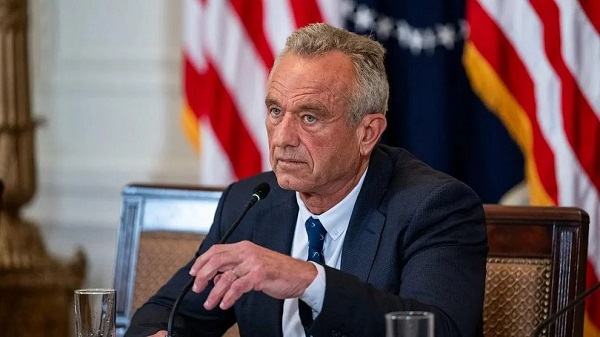Uncategorized
UN Ambassador Haley resigning in latest Trump shakeup

WASHINGTON — U.N. Ambassador Nikki Haley is resigning, she and President Donald Trump announced Tuesday, blindsiding many administration officials and stirring speculation in the White House and beyond about the timing and reasons for the latest Trump shake-up just weeks before the November midterm elections.
The news was news to many congressional Republicans involved in foreign policy matters, and some key U.S. allies did not get advance word from Haley or the White House. Neither she nor Trump gave any specific reason.
“I have given everything I’ve got these last eight years,” she said, referring to her six years as South Carolina governor as well as her time at the U.N. “And I do think it’s good to rotate in other people who can put that same energy and power into it.”
There has been speculation that Haley, one of the highest-profile women in the administration, will return to government or politics at some point.
“No, I’m not running in 2020” for president, she joked, quickly adding that she would be supporting Trump.
The decision to announce the latest shake-up came less than a month before the elections, even as the White House has made a concerted effort to hold off on major changes — at the Justice Department and elsewhere — before then.
Trump was asked why the announcement was made now since Haley is staying until the end of the year.
Instead of answering directly, he recounted how she has had to work on tough issues, such as Iran and North Korea.
White House officials had sought to put a hold on record-setting administration turnover in the run-up to the Nov. 6 elections, with aides being asked months ago to step down or commit to stay through Election Day to avoid adding to a sense of turmoil.
Still, the prospect of post-midterm changes has loomed over the West Wing, and Haley’s exit was one of those discussed, according to a senior administration official not authorized to publicly discuss private conversations.
Despite Trump’s calm words, her sudden announcement rattled a number in the White House, who openly speculated that the timing was meant to preserve the ambassador’s own political future, according to the official and another White House official.
Trump said Haley first discussed leaving the administration with him six months ago. The official noted that their conversation coincided with the appointment of Mike Pompeo as secretary of state and John Bolton as national security adviser. Haley had expressed some frustration that her voice had been diminished as the two men became the aggressive new faces of Trump’s foreign policy, the official said.
More recently, there was an awkward moment at the U.N., when Trump’s boasting of American economic strength under his leadership drew laughter at a General Assembly session. He insisted later that the delegates were laughing with him, not at him.
The six-month timeline also coincides with a high-profile spat between Haley and the White House in April, when she drew the president’s ire for previewing in a television appearance the administration’s planned imposition of a new round of sanctions on Russia. When the sanctions never materialized, White House officials said the plans had changed without Haley being briefed, and top economic adviser Larry Kudlow suggested Haley was confused.
“I don’t get confused,” Haley said in a sharply-worded rejoinder to the West Wing.
Haley, 46, was appointed to the U.N. post in November 2016 and last month
A rookie to international politics, the former South Carolina governor was an unusual pick for to be U.N. envoy. At the U.N., she helped spearhead the administration’s efforts to combat what it alleged to be anti-American and anti-Israel actions by the international body, and address U.S. tension with its European allies and with Iran and North Korea.
“It was a blessing to go into the U.N. every day with body
Trump said he was considering many candidates for Haley’s job and that a successor would be named in two to three weeks — or maybe sooner.
Last month Haley wrote an op-ed article in The Washington Post discussing her policy disagreements but also her pride in working for Trump. It came in response to an anonymous essay in The New York Times by a senior administration official that alleged there to be a secret “resistance” effort from the right in Trump’s administration and that there were internal discussions of invoking the 25th amendment to remove him from office.
“I proudly serve in this administration, and I enthusiastically support most of its decisions and the direction it is taking the country,” Haley wrote. “But I don’t agree with the president on everything.”
The daughter of Indian immigrants, Haley clashed with then-candidate Trump during the 2016 campaign, denouncing “the siren call of the angriest voices” that disrespected America’s immigrants. Trump tweeted that “The people of South Carolina are embarrassed by Nikki Haley.”
“Before she was named by Trump to her U.N. post, Haley was elected the first female governor of South Carolina. She was re-elected in 2014. As governor, she developed a national reputation as a racial conciliator who led the charge to bring down the Confederate flag at the Statehouse and helped guide the state through one of its darkest moments, the massacre at a black church.
South Carolina Republican Sen. Lindsey Graham, a close Trump ally tweeted that Haley “has a very bright future and will be a key player in both the future of the Republican Party and our nation as a whole for years to come.”
“I want to thank Ambassador Haley for her willingness to express moral clarity to the world and to President Trump, and promote American values and leadership on the global stage, even when she lacked the backing of the White House or State Department.
Sen. Bob Menendez of New Jersey, the ranking Democrat on the Senate Foreign Relations Committee, said Haley’s leaving is “yet another sign of the Trump administration’s chaotic foreign policy and setback from promoting American values and priorities.” Menendez said he is concerned about the leadership vacuum she leaves and “the national security impact of her departure at this time of continued disarray for this administration.”
___
Lemire reported from New York. Associated Press writers Matthew Lee in Washington, and Meg Kinnard in Columbia, South Carolina contributed to this report.
Zeke Miller, Deb Riechmann And Jonathan Lemire, The Associated Press
Uncategorized
Mortgaging Canada’s energy future — the hidden costs of the Carney-Smith pipeline deal


Much of the commentary on the Carney-Smith pipeline Memorandum of Understanding (MOU) has focused on the question of whether or not the proposed pipeline will ever get built.
That’s an important topic, and one that deserves to be examined — whether, as John Robson, of the indispensable Climate Discussion Nexus, predicted, “opposition from the government of British Columbia and aboriginal groups, and the skittishness of the oil industry about investing in a major project in Canada, will kill [the pipeline] dead.”
But I’m going to ask a different question: Would it even be worth building this pipeline on the terms Ottawa is forcing on Alberta? If you squint, the MOU might look like a victory on paper. Ottawa suspends the oil and gas emissions cap, proposes an exemption from the West Coast tanker ban, and lays the groundwork for the construction of one (though only one) million barrels per day pipeline to tidewater.
But in return, Alberta must agree to jack its industrial carbon tax up from $95 to $130 per tonne at a minimum, while committing to tens of billions in carbon capture, utilization, and storage (CCUS) spending, including the $16.5 billion Pathways Alliance megaproject.
Here’s the part none of the project’s boosters seem to want to mention: those concessions will make the production of Canadian hydrocarbon energy significantly more expensive.
As economist Jack Mintz has explained, the industrial carbon tax hike alone adds more than $5 USD per barrel of Canadian crude to marginal production costs — the costs that matter when companies decide whether to invest in new production. Layer on the CCUS requirements and you get another $1.20–$3 per barrel for mining projects and $3.60–$4.80 for steam-assisted operations.
While roughly 62% of the capital cost of carbon capture is to be covered by taxpayers — another problem with the agreement, I might add — the remainder is covered by the industry, and thus, eventually, consumers.
Total damage: somewhere between $6.40 and $10 US per barrel. Perhaps more.
“Ultimately,” the Fraser Institute explains, “this will widen the competitiveness gap between Alberta and many other jurisdictions, such as the United States,” that don’t hamstring their energy producers in this way. Producers in Texas and Oklahoma, not to mention Saudi Arabia, Venezuela, or Russia, aren’t paying a dime in equivalent carbon taxes or mandatory CCUS bills. They’re not so masochistic.
American refiners won’t pay a “low-carbon premium” for Canadian crude. They’ll just buy cheaper oil or ramp up their own production.
In short, a shiny new pipe is worthless if the extra cost makes barrels of our oil so expensive that no one will want them.
And that doesn’t even touch on the problem for the domestic market, where the higher production cost will be passed onto Canadian consumers in the form of higher gas and diesel prices, home heating costs, and an elevated cost of everyday goods, like groceries.
Either way, Canadians lose.
So, concludes Mintz, “The big problem for a new oil pipeline isn’t getting BC or First Nation acceptance. Rather, it’s smothering the industry’s competitiveness by layering on carbon pricing and decarbonization costs that most competing countries don’t charge.” Meanwhile, lurking underneath this whole discussion is the MOU’s ultimate Achilles’ heel: net-zero.
The MOU proudly declares that “Canada and Alberta remain committed to achieving Net-Zero greenhouse gas emissions by 2050.” As Vaclav Smil documented in a recent study of Net-Zero, global fossil-fuel use has risen 55% since the 1997 Kyoto agreement, despite trillions spent on subsidies and regulations. Fossil fuels still supply 82% of the world’s energy.
With these numbers in mind, the idea that Canada can unilaterally decarbonize its largest export industry in 25 years is delusional.
This deal doesn’t secure Canada’s energy future. It mortgages it. We are trading market access for self-inflicted costs that will shrink production, scare off capital, and cut into the profitability of any potential pipeline. Affordable energy, good jobs, and national prosperity shouldn’t require surrendering to net-zero fantasy.If Ottawa were serious about making Canada an energy superpower, it would scrap the anti-resource laws outright, kill the carbon taxes, and let our world-class oil and gas compete on merit. Instead, we’ve been handed a backroom MOU which, for the cost of one pipeline — if that! — guarantees higher costs today and smothers the industry that is the backbone of the Canadian economy.
This MOU isn’t salvation. It’s a prescription for Canadian decline.
Uncategorized
Cost of bureaucracy balloons 80 per cent in 10 years: Public Accounts

The cost of the bureaucracy increased by $6 billion last year, according to newly released numbers in Public Accounts disclosures. The Canadian Taxpayers Federation is calling on Prime Minister Mark Carney to immediately shrink the bureaucracy.
“The Public Accounts show the cost of the federal bureaucracy is out of control,” said Franco Terrazzano, CTF Federal Director. “Tinkering around the edges won’t cut it, Carney needs to take urgent action to shrink the bloated federal bureaucracy.”
The federal bureaucracy cost taxpayers $71.4 billion in 2024-25, according to the Public Accounts. The cost of the federal bureaucracy increased by $6 billion, or more than nine per cent, over the last year.
The federal bureaucracy cost taxpayers $39.6 billion in 2015-16, according to the Public Accounts. That means the cost of the federal bureaucracy increased 80 per cent over the last 10 years. The government added 99,000 extra bureaucrats between 2015-16 and 2024-25.
Half of Canadians say federal services have gotten worse since 2016, despite the massive increase in the federal bureaucracy, according to a Leger poll.
Not only has the size of the bureaucracy increased, the cost of consultants, contractors and outsourcing has increased as well. The government spent $23.1 billion on “professional and special services” last year, according to the Public Accounts. That’s an 11 per cent increase over the previous year. The government’s spending on professional and special services more than doubled since 2015-16.
“Taxpayers should not be paying way more for in-house government bureaucrats and way more for outside help,” Terrazzano said. “Mere promises to find minor savings in the federal bureaucracy won’t fix Canada’s finances.
“Taxpayers need Carney to take urgent action and significantly cut the number of bureaucrats now.”
Table: Cost of bureaucracy and professional and special services, Public Accounts
| Year | Bureaucracy | Professional and special services |
|
$71,369,677,000 |
$23,145,218,000 |
|
|
$65,326,643,000 |
$20,771,477,000 |
|
|
$56,467,851,000 |
$18,591,373,000 |
|
|
$60,676,243,000 |
$17,511,078,000 |
|
|
$52,984,272,000 |
$14,720,455,000 |
|
|
$46,349,166,000 |
$13,334,341,000 |
|
|
$46,131,628,000 |
$12,940,395,000 |
|
|
$45,262,821,000 |
$12,950,619,000 |
|
|
$38,909,594,000 |
$11,910,257,000 |
|
|
$39,616,656,000 |
$11,082,974,000 |
-

 Alberta2 days ago
Alberta2 days agoOttawa-Alberta agreement may produce oligopoly in the oilsands
-

 Energy2 days ago
Energy2 days agoThe Top News Stories That Shaped Canadian Energy in 2025 and Will Continue to Shape Canadian Energy in 2026
-

 Energy2 days ago
Energy2 days agoWestern Canada’s supply chain for Santa Claus
-

 International2 days ago
International2 days ago$2.6 million raised for man who wrestled shotgun from Bondi Beach terrorist
-

 Frontier Centre for Public Policy16 hours ago
Frontier Centre for Public Policy16 hours agoTent Cities Were Rare Five Years Ago. Now They’re Everywhere
-

 armed forces17 hours ago
armed forces17 hours agoRemembering Afghanistan and the sacrifices of our military families
-

 Fraser Institute17 hours ago
Fraser Institute17 hours agoHow to talk about housing at the holiday dinner table
-

 Fraser Institute2 hours ago
Fraser Institute2 hours agoCarney government sowing seeds for corruption in Ottawa










